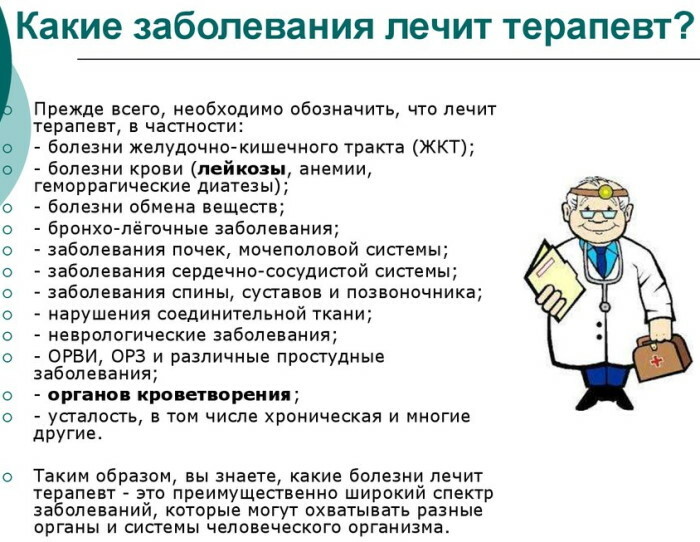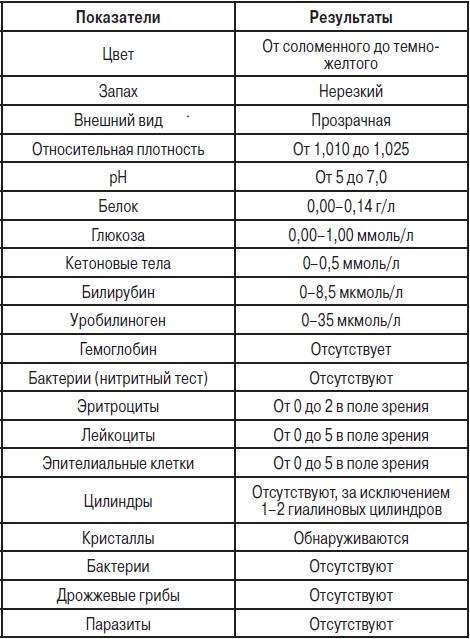Content
- What is a therapist?
- Responsibilities of a specialist
- Requirements for the profession
- What diseases does the therapist treat?
- What are the symptoms of referring to a therapist?
- Where does it take?
- How do I prepare for my initial visit?
- What physical and instrumental research does the therapist conduct?
- What tests does the doctor prescribe and for what?
- General blood analysis
- General urine analysis
- General analysis of feces (coprogram)
- Blood glucose test
- Lipidogram
- Coagulogram
- The main methods and directions of treatment
- Video about therapist
To a therapist as a doctor first instance, treat any painful symptoms and ailments. The exceptions are problems that require prompt surgical intervention. The patient receives an initial consultation, examination and, if necessary, treatment. If the disease requires the attention of a highly specialized doctor, the patient will be referred to him for an appointment.
What is a therapist?
The word "therapist", like many medical terms, is of Greek origin (therapeutes) and literally means "caregiver", "treating". Since the days of "Hippocratic" medicine, therapists have been treating patients exclusively using conservative methods.
A therapist is a general medical specialist, a universal doctor who has an understanding of the treatment, diagnosis and prevention of internal diseases, and has received appropriate training.
His areas of competence include diseases of internal organs and systems of the human body, including:
- breathing;
- blood circulation;
- digestion;
- kidney pathologies;
- connective tissue;
- metabolism;
- endocrine glands.
A physician is traditionally considered to be any doctor who does not resort to surgical methods for treatment. Therefore, cardiologists, endocrinologists, nephrologists and other specialists are referred to as general practitioners, but to “narrow-profile” ones. Their activities are limited to one organ system, in which they have more in-depth knowledge and skills compared to general practitioners.
In practice, a therapist is understood as a doctor who conducts an appointment at a medical institution, advising on all non-surgical diseases. In a polyclinic, this is a district general practitioner who provides medical and preventive care to residents of the assigned area.
This is the most numerous and at the same time demanded medical specialty: the therapeutic service accounts for up to 60% of all visits to polyclinics and up to 90% of all home calls. The therapist relieves the burden on his “narrow-profile” colleagues when the management of the disease does not require referral to them.
Responsibilities of a specialist
The role of the therapist is to provide qualified medical care at the primary level of health care delivery. In addition, if necessary, the therapist performs the function of a "coordinator", that is, directs the patient to specialized specialists or to hospitalization.
The duties assigned to the therapist are mainly related to patients who first seek help from a medical institution.
They include:
- The initial appointment of the patient, as a result of which, after collecting an anamnesis and examination, including physical examinations, the therapist makes a preliminary diagnosis. Then the circle of necessary laboratory, hardware and instrumental studies is determined.
- Interpretation of examination results, diagnosis and treatment.
- In the presence of medical indications - referral of the patient for consultation to narrow-profile specialists or for treatment in a hospital. If necessary, the therapist is able to provide first aid before hospitalization.
- Follow-up of the patient after discharge from the hospital and referral to physiotherapy, spa treatment; appointment of other rehabilitation measures.
Half of the success in establishing a diagnosis is provided by the correct collection of anamnesis (medical history and living conditions of the patient); one third - physical examinations, and the rest - laboratory and instrumental examination methods. At the same time, a polyclinic therapist should take 5 patients in 1 hour. With such a standard of service, the doctor is obliged to master the skills of questioning the patient well, and even masterly, in order to have time to get all the information necessary to understand the patient's condition.
The conversation between the therapist and the patient during the initial consultation is important. During it, the doctor provides the patient with information about the disease that has befallen him in the required volume, explains the causes of the disease and outlines the course of the upcoming treatment. Patient awareness has a positive effect on his condition and increases the chances of success in therapy.
The therapist treats a number of diseases, and also conducts the following actions and activities:
- Examination of the patient before vaccination.
- Issuance of an opinion after a medical examination.
- Filling out sick leaves and writing prescriptions.
- Dispensary observation of patients with chronic diseases of internal organs (preventive examinations).
- Identification of patients with tuberculosis, helminthiasis and cancer. Referral to specialized specialists: phthisiatrician, infectious disease specialist and oncologist, respectively.
- SES notification of outbreaks of infectious diseases and participation in anti-epidemic measures.
The duties of a local therapist also include:
- Home visits.
- Referral of patients with persistent dysfunctions of the body for medical and social expertise, preparation of the necessary documentation and work as part of a medical commission that determines the degree disability.
Once having prescribed treatment, the therapist "leads" the patient: he observes his condition in dynamics and controls the course of therapy. Even after being referred to a “narrow” specialist, a patient with diseases of internal organs remains under the supervision of a therapist at the same time.
So, together with a cardiologist, the therapist observes patients with cardiomyopathy, with myocardial infarction. Patients with non-infectious chronic hepatitis see a therapist and gastroenterologist; with chronic lung abscess - therapist and pulmonologist.
To monitor the course of the disease, the therapist conducts periodic appointments. A referral for a consultation with a narrow-profile doctor is prescribed for medical reasons or according to the regulations. So, cases of chronic pyelonephritis are observed by a therapist, but 1-2 times a year the patient should be sent for a consultation with a nephrologist.
Requirements for the profession
Higher medical education is a prerequisite for working as a therapist. After graduating from a medical institute, a doctor undergoes training in an internship (residency) in the specialty "Therapy" for 1 year. Since 2017, it is enough to work as a therapist in a polyclinic for a medical student in the last year of the institute to complete a specialty in the specialty "General Medicine".
In the presence of the specialty "General practice" related to family medicine, the doctor must undergo retraining in the specialty "Therapy".
The general therapist considers the human body as a whole, without dividing it into separate fragments. His medical horizons must be broad enough to be able to diagnose and treat most common diseases. Therefore, continuous acquisition of new knowledge is important for a good specialist. For continuous professional growth, a doctor needs to participate in seminars, trainings, advanced training and retraining programs, and independently read medical literature.
The therapist, like other Russian doctors, is obliged to observe medical confidentiality and the Doctor's Oath. An indispensable condition is the observance of the patient's rights, medical ethics and knowledge of that part of the legislation that is related to the field of health protection.
What diseases does the therapist treat?
The therapist treats patients with the following diseases:
- SARS, including influenza;
- mild forms of bronchial asthma and chronic bronchitis (without shortness of breath);
- hypertension, amenable to drug therapy;
- stable forms of heart failure and coronary heart disease;
- vegetative-vascular dystonia;
- gastroesophageal reflux disease (GERD) and gastritis (without signs of cancerous degeneration);
- chronic colitis;
- non-viral liver damage, and monitoring is carried out in conjunction with a hepatologist;
- chronic pancreatitis and gallstone disease, if exacerbations do not require surgical intervention;
- kidney disease, including CKD (chronic kidney disease) in stages 1-3;
- type 2 diabetes mellitus;
- lipid metabolism disorders;
- mild course of gout (with moderate and severe, the patient is transferred to a rheumatologist);
- diseases of the joints (arthritis, arthrosis) and the entire bone skeleton (osteoporosis);
- anemia, except for its hemolytic form, which requires referral to a hematologist.

Therapist what heals
The therapist selects the optimal treatment regimens, taking into account the recommendations of narrowly focused specialists.
What are the symptoms of referring to a therapist?
Any signs of a deterioration in well-being can become a reason for contacting a therapist. In many cases, it is not clear to the person what he got sick, or he misinterprets the symptoms. So, patients usually attribute the cough to a cold.
However, this symptom may be associated with chronic heart failure (CHF) or with dysfunction of the esophageal sphincter. Painful disorders often affect several organs at once. The general therapist is able to assess the totality of symptoms, therefore, it is better to entrust the process of determining the diagnosis to this specialist.
The main symptoms that require the attention of the therapist:
| Symptom | Possible reasons |
| Weakness, fatigue | Anemia, diabetes mellitus, vegetative-vascular dystonia. The cause can be any disease causing oxygen deprivation, including heart failure and malignant tumor. |
| Temperature increase | SARS, pneumonia, pyelonephritis and other infectious and inflammatory diseases. A constant rise in temperature in the region of 37.5-38 ° C without other noticeable symptoms may indicate a malignant tumor, tuberculosis, thyroid diseases. |
| Severe headaches | ARVI, hypertension, cervical osteochondrosis. The cause may be diabetes mellitus, in which toxins accumulate in the blood. |
| Sudden weight loss unrelated to diet | Diabetes mellitus, malignant tumors, liver cirrhosis. The symptom may be associated with a violation of the digestive process, which is characteristic of chronic pancreatitis, colitis, peptic ulcer disease. |
| Digestive disorders | Vomiting, nausea, heartburn accompany diseases of the digestive system. Diarrhea can be a symptom of ARVI, and vomiting is one of the signs of a hypertensive crisis. |
| Disorders of urination | Diabetes mellitus, prostate adenoma, CHF. Frequent or rare urination can be in diseases of the kidneys and urinary tract: urolithiasis, chronic pyelonephritis, cystitis. |
| Discoloration of the skin | Pallor of the skin, uncharacteristic for the patient's usual condition, may indicate internal blood loss in gastric ulcer. Constant pallor, sometimes cyanosis - about anemia, CHF. The skin acquires a yellow tint with an excess of bilirubin in the blood with hepatitis, liver cirrhosis, cholecystitis. |
| Dizziness and fainting | The conditions are associated with a lack of oxygen in the brain tissues. The reasons are varied: anemia, heart muscle dysfunction. Oxygen deficiency in the vessels of the brain causes compression of the vertebral artery in cervical osteochondrosis. In the late stage of chronic bronchitis, the process of gas formation in the lungs is disrupted, which also causes dizziness. |
| Bloody vomiting or coughing up blood | Vomiting of blood can be a sign of ulcerative lesions of the gastrointestinal mucosa. Hemoptysis - tuberculosis and lung cancer. |
| Abdominal pain | Pain in the upper abdomen occurs with myocardial infarction, gastritis, and gallstone disease. In the lower part - with enteritis, chronic colitis. |
| Cough | ARVI, lung disease, GERD. A persistent, dry cough is caused by the use of certain ACE inhibitors (Trandolapril), drugs that lower blood pressure. |
 The doctor comes to the house if there is a sharp and severe deterioration in the state of health, or it is difficult for the patient to visit the clinic.
The doctor comes to the house if there is a sharp and severe deterioration in the state of health, or it is difficult for the patient to visit the clinic.
Where does it take?
The therapist can work in different types of medical institutions:
- polyclinic - as a district therapist;
- a hospital or private clinic - as a physician in the internal medicine or admission department;
- centers with diagnostic and laboratory equipment, where he acts as a consultant physician.
How do I prepare for my initial visit?
First of all, you need to make an appointment with a therapist. To do this, you can contact the clinic's registry or use the appropriate online services.
The day before the visit, you should not drink alcohol and those medications that can blur the picture of the disease. Medicines prescribed by a doctor should not be canceled.
It is advisable to take a shower - this is not mandatory, but an ethical requirement.
The therapist treats the disease, but the success of the treatment also depends on the patient's activity, his involvement and understanding of the process. When preparing for an appointment, it is worthwhile to draw up a list of questions of interest in advance. If "on hand" there are the results of medical examinations (X-rays, cardiogram, blood and urine tests), it is better to decompose them by dates - so it will be more convenient for the doctor to see the dynamics of the disease. There is little time for the patient's appointment, and this will help to use it rationally.
What physical and instrumental research does the therapist conduct?
In the arsenal of the therapist there are a number of simple tools: a magnifying glass, scales with a height rod and a measuring tape. With their help, the doctor assesses the patient's physique, the condition and color of his skin, mucous membranes.
Next, the doctor proceeds to other physical diagnostic methods:
- Palpation - palpation of parts of the body, which is carried out using pressure or movement of the fingers and palm. Using the method, the physical properties of organs and tissues are assessed: size, position, mobility and density; establish the presence and degree of their pain.
- Percussion — tapping. By the nature of the sounds received, the topography of the organs, changes in the lungs and heart are analyzed, the boundaries of the liver and spleen are determined.
- Auscultation - listening to pulmonary respiration, heart murmurs and arterial blood flow. It is carried out with a stethoscope.
The therapist also measures the patient's blood pressure and, if necessary, the blood sugar level with a glucometer.
What tests does the doctor prescribe and for what?
To clarify the alleged diagnosis, the therapist prescribes laboratory tests. In some cases, additional research is needed in order, on the contrary, to exclude the suspicion of any disease.
Blood, urine, and stool tests are almost always done. These are simple, “nonspecific” studies that provide a broad view of the health status and allow you to understand in which direction to go in determining the diagnosis and treatment.
General blood analysis
The study is prescribed in order to diagnose inflammatory and infectious diseases, anemia and if an oncological process is suspected. The main indicators, which, first of all, the therapist focuses on: ESR, hemoglobin, leukocytes and leukocyte formula.
Further research is carried out to monitor the dynamics of the disease and the effectiveness of the treatment. During pregnancy, blood tests are done at least 4 times; the last one - just before childbirth. Blood is taken from a finger or from a vein and not earlier than 4 hours after a meal.
General urine analysis
The composition of urine is related to the composition of the blood, and therefore can provide information about the state of many organs and systems of the body. General, or clinical, urinalysis is prescribed to diagnose diseases of the urinary system and kidneys.
The reason is such symptoms as:
- the appearance of blood in the urine;
- pain and pain when urinating;
- pain in the lower abdomen and lower back;
- increased body temperature.

The analysis is carried out to assess the state of the body and for other diseases, as well as as part of preventive examinations during medical examination and in pregnant women.
General analysis of feces (coprogram)
Scatological research gives an idea of the work of the digestive system. Excreta samples are examined visually, using chemical samples and under a microscope.
The presence of leukocytes in the stool suggests ulcerative colitis or bowel cancer. Fatty acids are found in cholelithiasis and inflammation of the pancreas; eggs worm - with helminthiasis. The appearance of erythrocytes indicates ulcerative processes in the gastrointestinal mucosa and is the reason for the appointment of a fecal occult blood test.
Collect fresh feces obtained after sleep. The procedure is not done immediately after rectal examinations, EGDS, during menstruation in women.
Blood glucose test
Fasting blood glucose is taken from a finger or a vein after 8 hours of fasting. The analysis is necessary to understand whether glucose is properly absorbed and used by the body. The study is necessary to diagnose disorders of carbohydrate metabolism. Glucose increases with pancreatitis and impaired renal excretory function.
Lipidogram
The study is resorted to when the patient has complaints characteristic of cardiovascular diseases.
Analyze the content of lipids (fat-like substances) in the blood: cholesterol, triglycerides, lipoproteins. Blood is taken from a vein on an empty stomach, excluding fatty foods from the diet the day before the procedure.
The study is carried out during preventive examinations of large groups of the population in order to timely identify or reduce the risk of developing atherosclerosis, heart attack, stroke and coronary heart disease. People over 40 need to have their blood lipid profile checked annually.
Coagulogram
In the course of the study, the characteristics of blood clotting are studied. Increased clotting causes blood clots; reduced leads to internal bleeding. In combination with other diagnostic methods, a coagulogram makes it possible to assess the degree of risk of such problems.
Find out the time required to start and end the process of blood coagulation after taking it for analysis; determine the level of fibrinogen and other proteins formed in the liver with the participation of vitamin K and involved in the process of clotting and formation of a blood clot.
The indications for the analysis are frequent bleeding, easily appearing bruises, diseases of the heart, blood vessels and liver. Monitoring the effectiveness of anticoagulant treatment, taking contraceptives, and the upcoming elective surgery also require a coagulogram.
The analysis is taken in the morning, on an empty stomach. A glass of water is drunk 15-20 minutes before entering the treatment room.
The main methods and directions of treatment
The therapist prescribes medications based on the diagnosis, age and condition of the patient, as well as existing clinical guidelines. In necessary cases, physiotherapy and spa treatment are used. The doctor's advice on adherence to the diet, work and life is of great importance.
The purpose of the therapist's activity is to preserve and strengthen the health of the population. This doctor is not only the first to meet the patient in the clinic, diagnose and treat the patient: he is engaged in prevention of common diseases, organizing preventive examinations and explaining the principles of healthy lifestyle.
Video about therapist
What the therapist treats:



